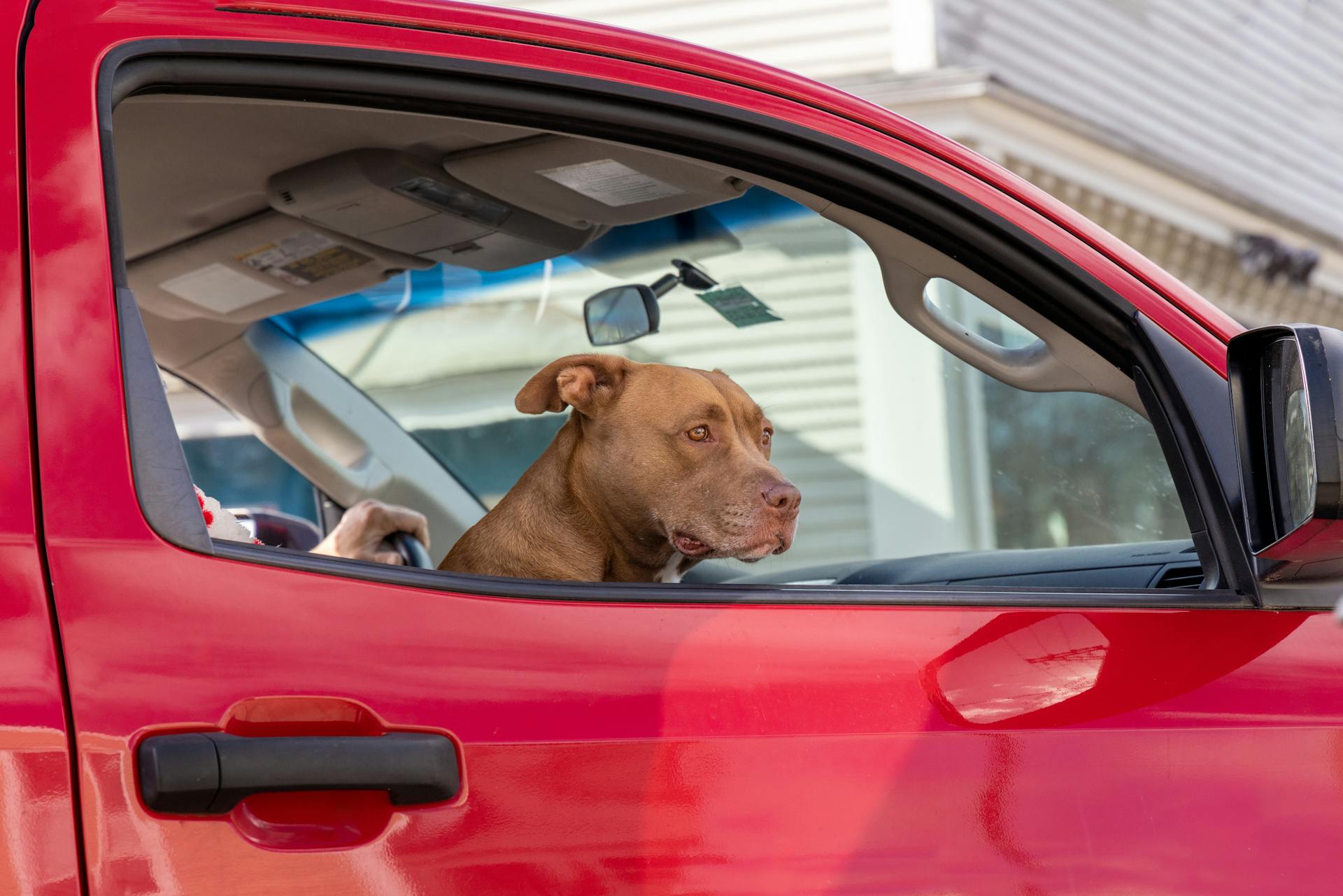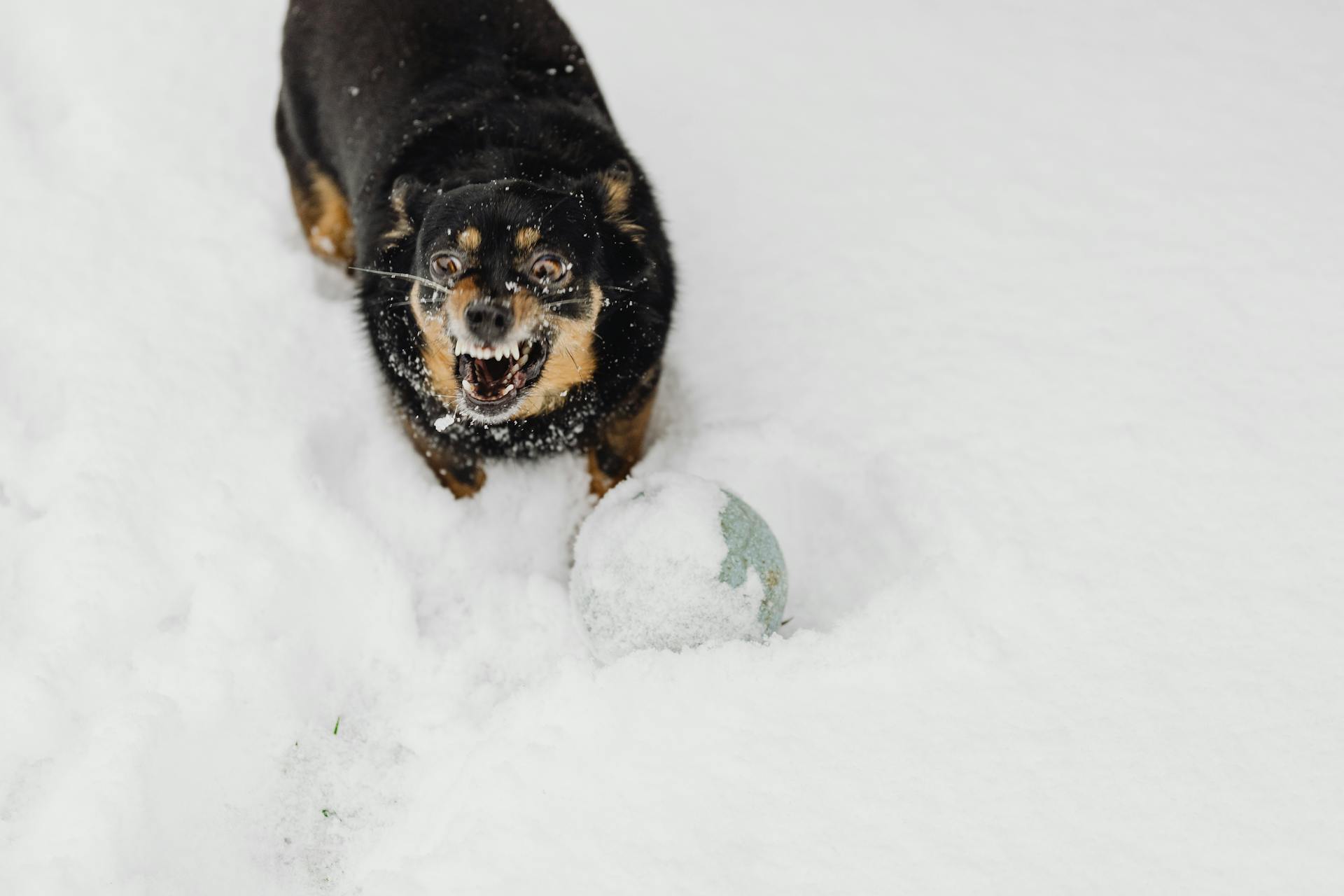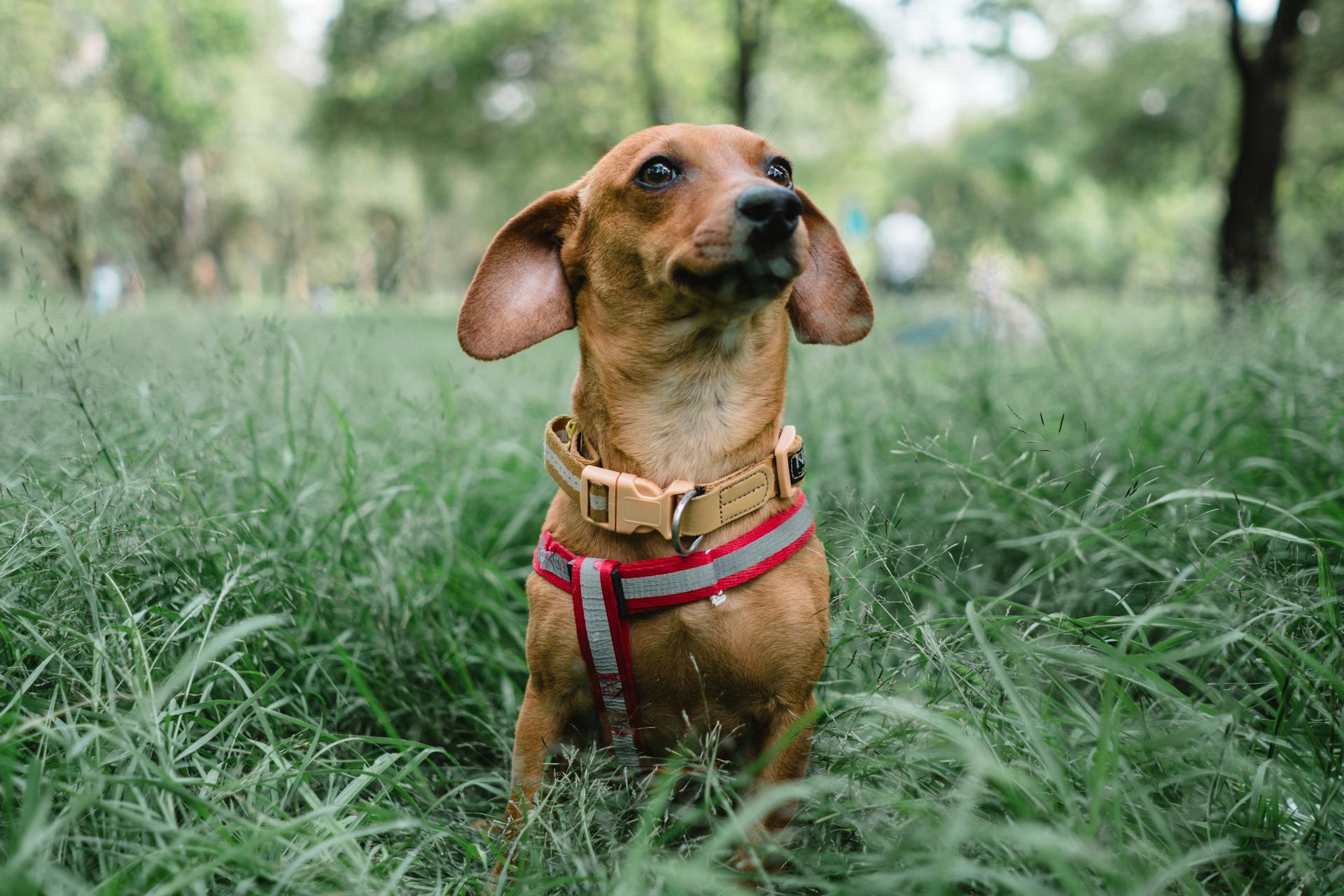
As dogs age, they can exhibit changes in behavior that may seem aggressive, but are often a sign of underlying health issues or cognitive decline. Senior dogs may become more territorial and protective of their resources, leading to growling or snapping at people or other animals.
Changes in a senior dog's environment can trigger these behaviors, such as moving to a new home or introducing new pets or family members. This can cause them to feel anxious or stressed, leading to aggression.
According to research, up to 50% of senior dogs experience cognitive decline, which can lead to confusion, anxiety, and aggression. This decline can start as early as 7 years old, depending on the breed and size of the dog.
Dogs with arthritis or other chronic pain may also become more irritable and aggressive as they age. This is because pain can cause them to feel anxious and defensive, leading to behavioral changes.
Broaden your view: When Do Cane Corsos Become Protective
What It Looks Like
Senior dog aggression can be a concerning issue for many pet owners. It's essential to recognize the signs of aggression in older dogs to ensure their safety and the safety of those around them.
A dog displaying aggression may stand very still with a rigid posture, a clear warning sign that they're feeling threatened or uncomfortable.
Direct eye contact and holding it can also be a sign of aggression in dogs. This behavior is often accompanied by other warning signs, such as a growl or bark in a threatening tone.
Flattening the ears against the head is another common sign of aggression in dogs. It's a subtle behavior that can be easy to miss if you're not paying close attention.
Growling or barking in a threatening tone is a clear warning sign that a dog is feeling aggressive. It's a signal that they're preparing to take action.
Snarling is a common sign of aggression in dogs, and it's often accompanied by a curled lip and exposed teeth.
You might like: Signs of Prey Drive in Dogs
Here is a list of common signs of aggression in dogs:
- Stand very still with a rigid posture
- Make direct eye contact and hold it
- Flatten the ears against the head
- Growl or bark in a threatening tone
- Snarl
- Curl its lips to expose its teeth
- Lunge forward without making contact
- Snap without making contact
- Bite lightly so as not to break the skin
- Bite hard enough to break the skin or leave a mark
It's essential to recognize these signs of aggression in older dogs to prevent injuries and provide a safe environment for everyone involved.
Causes of Aggression in Senior Dogs
As our dogs age, they can become more aggressive due to age-related changes that may have been present since they were younger. If your senior dog exhibited aggressive behavior at a younger age, it might have escalated or worsened with age.
Age can also bring new challenges that may cause aggression in an otherwise sweet older dog. Several factors can contribute to this change in behavior.
Older dogs may become more protective of their territory, possessions, or loved ones, leading to aggressive behaviors. This is a normal response to their instinctive pack behavior.
Dogs suffering from painful injuries or health conditions can act hostile, like growling and nipping at you if you touch a sore arthritic joint or try to examine a bruised paw.
A different take: Potty Training an Adult Dog
Aggression Triggers
Identifying the triggers of your senior dog's aggression is crucial to addressing the issue.
Take note of situations when your dog shows aggression, and provide as much information as you can to your veterinarian or an animal behaviorist. This will help identify a pattern and may help your vet with the diagnosis.
Note the time of day, what behavior you witnessed, what your dog was doing right before it happened, and whether anyone was bothering the dog. For example, a dog that's chained in a yard may spend the day straining to get to a dog that lives across the street or in an adjacent yard.
Here are some specific factors to consider:
- Time of day: Aggression can be triggered by certain times of day, such as when your dog is hungry or tired.
- Behavior: Note what behavior you witnessed before the aggression occurred, such as barking or growling.
- Pre-aggression behavior: What was your dog doing right before it showed aggression?
- Interference: Was anyone bothering your dog before the aggression occurred?
Possessiveness
Possessiveness is a common trigger for aggression in dogs.
Dogs can be possessive of various things, including food, toys, and objects of value. They may growl, bite, or show aggression to protect these resources.
Resource guarding is a common cause of aggression towards other household pets. These pets may be approached by the dog's food bowl, bed, or favorite toy.
Here's an interesting read: Dog Obedience Classes and Trainers for Well-behaved Pets Scottsdale
A dog's degree of aggression can vary depending on the value it attributes to each object or resource. For instance, a dog may not mind if you pet it while it chews on a rubber toy, but it may snap at you if you do the same thing with a dental chew.
Some dogs may also exhibit aggression towards strangers who enter their territory, such as the mail carrier or people just outside the property boundary or fence. This is a common scenario where dogs may bark violently at people.
Frustration
Frustration is a common trigger for aggression in dogs, often referred to as redirected aggression or barrier frustration.
This type of aggression occurs when a dog is frustrated at not being able to get to something and takes its frustration out in another way. Dogs that spend a lot of time tied up, restrained on a leash, or behind a chain-link fence are more likely to exhibit this type of behavior.
A dog chained in a yard may spend the day straining to get to a dog that lives across the street or in an adjacent yard. The restrained dog usually barks and growls more fiercely as the frustration grows.
Redirected aggression may result in the dog biting the owner or lashing out at another family pet, whether canine or feline.
Triggers
Identifying triggers is a crucial step in understanding and addressing your dog's aggression. To do this, take note of situations when your dog shows aggression.
It's essential to gather as much information as possible to share with your veterinarian or an animal behaviorist. This can include the time of day, what behavior you witnessed, what your dog was doing right before it happened, and whether anyone was bothering the dog.
Make a conscious effort to film any incidents, as this can provide valuable visual evidence. This will help you and your veterinarian identify a pattern and make a more accurate diagnosis.

Here are some specific details to note:
- Time of day: Was your dog more aggressive at a specific time of day, such as during meal times or when visitors arrive?
- What behavior did you witness: Did your dog show aggression when you saw it playing with another dog, or when it was approached by a stranger?
- What was your dog doing right before it happened: Was your dog eating, sleeping, or engaging in some other activity?
- Was anyone bothering the dog: Were there any people, other animals, or loud noises that may have triggered your dog's aggression?
By paying attention to these details, you can begin to understand what triggers your dog's aggression and take steps to address it.
Managing Aggression
Managing aggression in senior dogs requires patience, understanding, and the right approach.
Identify the cause of your dog's aggression, as it's often linked to underlying problems that can be addressed.
Making small changes to your home and lifestyle can significantly impact your senior dog's comfort level and way of life.
For example, if your dog is skittish, introduce them to new experiences gradually to help them feel more at ease.
Avoid triggers that can set off your dog's aggression, and use positive reinforcement techniques like treats and clicker training to encourage good behavior.
Never yell at or physically punish your dog, as this can make the problem worse and even injure them.
Use safe and sturdy gear, such as a strong yet comfortable leash and collar or harness, to properly control your dog during walks.
Here are some key things to remember when managing your senior dog's aggression:
- Understand your dog's temperament and adjust your approach accordingly.
- Avoid triggers that can set off aggression.
- Use positive reinforcement techniques like treats and clicker training.
- Use safe and sturdy gear.
- Correct unwanted behaviors immediately.
Senior Dog Concerns
As our furry friends age, they can experience a range of changes that may lead to aggression. Anxiety can increase in dogs as they age, often due to joint pain, cognitive dysfunction, incontinence, and hearing loss.
It's essential to recognize the signs of anxiety in your senior dog, such as bad breath, pawing at their mouth, drooling, or losing interest in food or treats. If you notice any of these symptoms, take your dog to the vet right away.
Pain is a common cause of aggression in dogs, especially in older dogs. Arthritis, bone fractures, injuries, and tumors can all cause discomfort and stress, leading to aggression.
Some medical conditions, like cognitive dysfunction, brain tumors, and other brain diseases, can affect your dog's brain, causing unreasonable aggression. These problems are more likely to occur in older dogs but can happen at any age.
Dog dementia can lead to confusion, anxiety, and stress, causing an otherwise sweet-natured dog to display bouts of aggression. Imagine how you would feel if you were in a place you didn't recognize and surrounded by people you didn't remember.
A routine schedule and regular exercise can help soothe anxiety symptoms in your senior dog. Ensuring your older dog is with a family member through most of the day can also provide comfort and reduce anxiety.
You might like: How to Stop Dog Biting Lead
Getting Help
Identify the cause of your senior dog's aggression by consulting with your veterinarian, as it could be related to an injury or health condition.
Your veterinarian can offer suggestions for next steps if a health problem is ruled out.
Consult with a behavior specialist who can design a plan tailored to your dog's specific situation, as they are best equipped to treat aggression with behavioral modification.
Intriguing read: Why Does My Male Dog Lick My Female Dogs Pee
Getting Help
The first step in getting help for a problem is often the most crucial. You should start by identifying the cause of the issue.
A visit to your veterinarian can help rule out any underlying health problems that might be contributing to the issue. This is especially important if your dog is exhibiting aggressive behavior.
Consulting with a behavior specialist is key to designing a plan that addresses your dog's specific situation. They can help you identify the root cause of the problem and develop a treatment plan.
For more insights, see: Will Neutering a Dog Help with Aggression

You should not attempt to treat aggression on your own, as it can be ineffective and even dangerous if not done properly. It's always best to seek professional help.
Limiting exposure to potential triggers can help prevent further issues from arising. This might mean taking walks during quieter times of the day or avoiding busy pathways.
Take a look at this: Does Cbd Help with Dog Aggression
Comments
Comments can be a great way to get help, but it's essential to know how to use them effectively. Research shows that people who leave comments on online forums are more likely to get a response from the community.
A well-written comment can make all the difference in getting help. According to a study, comments that are clear, concise, and specific are more likely to get a response than vague or rambling ones.
Don't be afraid to ask for help, but do make sure you're asking the right people. As we discussed earlier, identifying the right experts or communities is crucial for getting the help you need.
A good comment should include relevant details, such as the problem you're trying to solve and any relevant background information. This helps others understand your situation and provide more accurate advice.
Check this out: Conditioned Emotional Response Dog Training
Tips and Advice
Don't assume your older dog is attacking the new puppy just because they're growling or snapping. They may be trying to convince the newcomer that they need space.
If your older dog is showing signs of aggression, don't dump them - they never asked for the change and shouldn't have to pay the consequences.
Give your older dog time to adjust to the new addition, and provide them with a safe space where they can retreat if needed.
Remember, older dogs have a right to their space and boundaries, and it's up to you to respect that.
Additional reading: Training Older Dog
Frequently Asked Questions
How to tell if an old dog is in pain?
Look for signs of panting, trembling, irritability, restlessness, or aggression in your old dog, as these can indicate hidden pain
Sources
- https://caringforaseniordog.com/aggression-in-older-dogs/
- https://news.orvis.com/dogs/senior-dog-behavior-changes-what-to-expect
- https://www.thesprucepets.com/top-causes-of-aggression-in-dogs-1117877
- https://www.aspcapetinsurance.com/resources/owners-guide-to-dog-aggression/
- https://greymuzzle.org/resources/authors-and-interviews/tips-reducing-aggression-your-senior-dog-devin-morrissey
Featured Images: pexels.com


